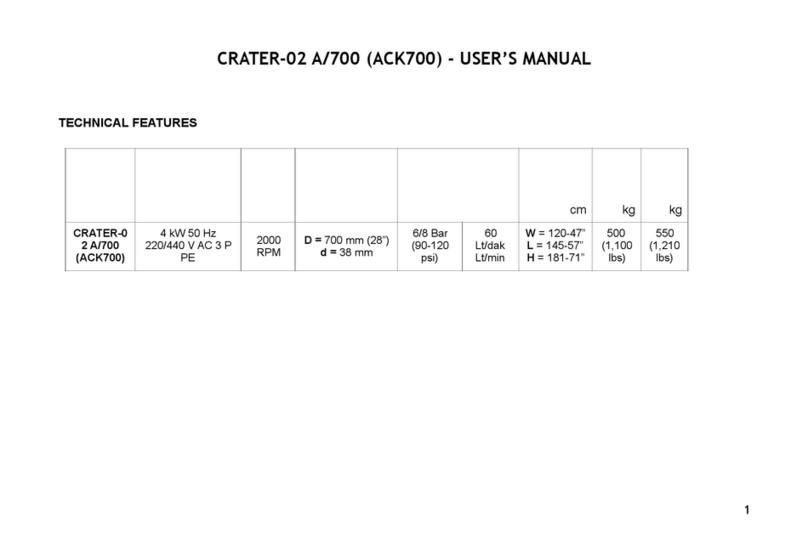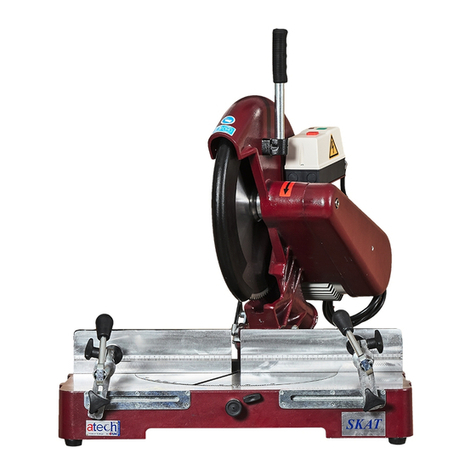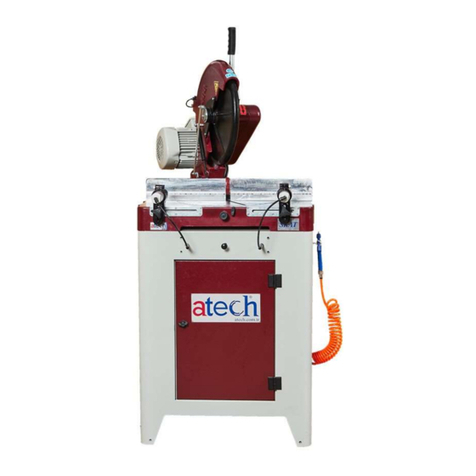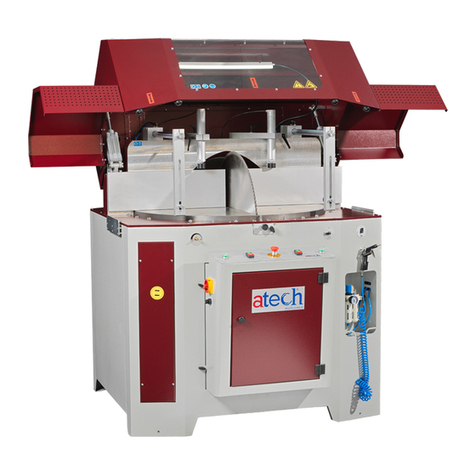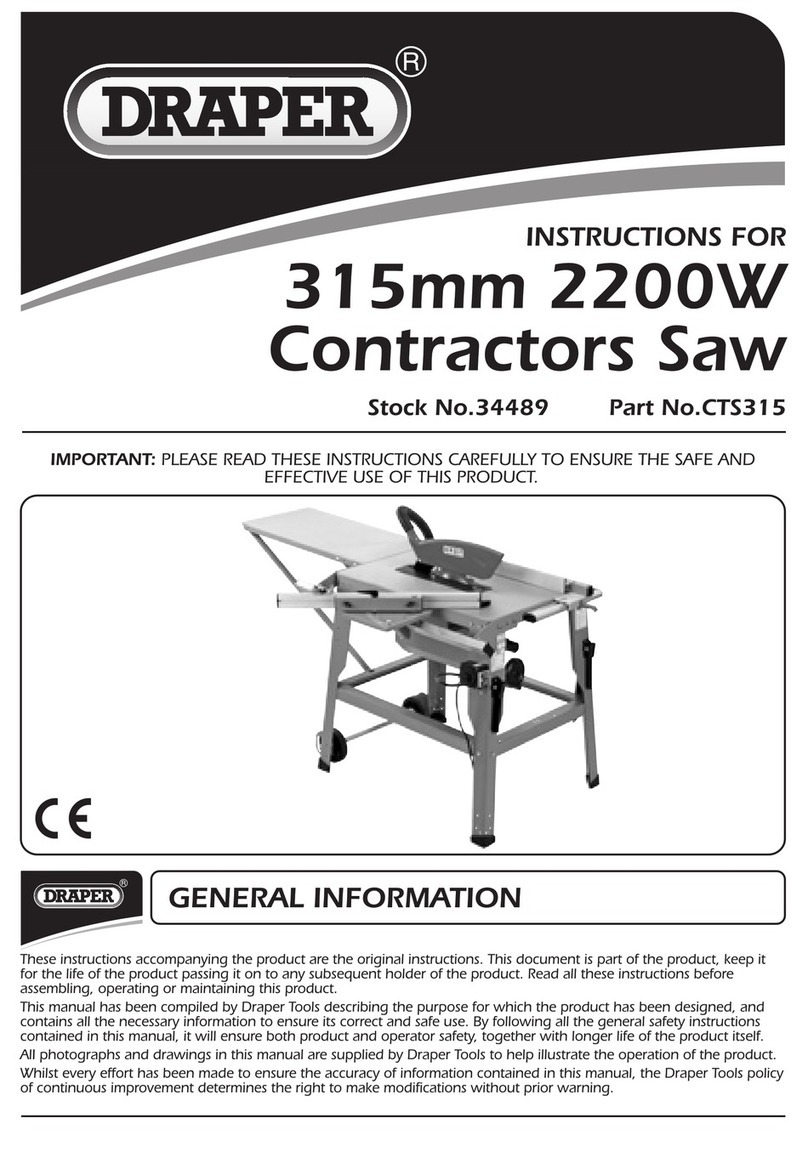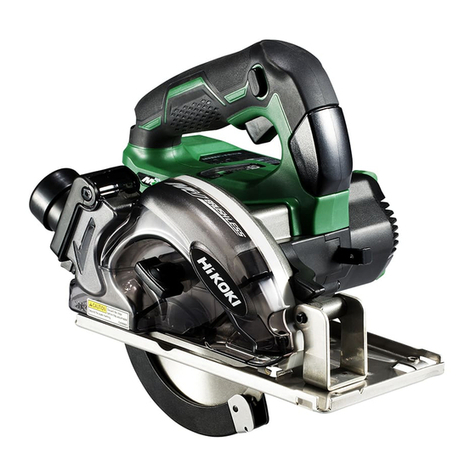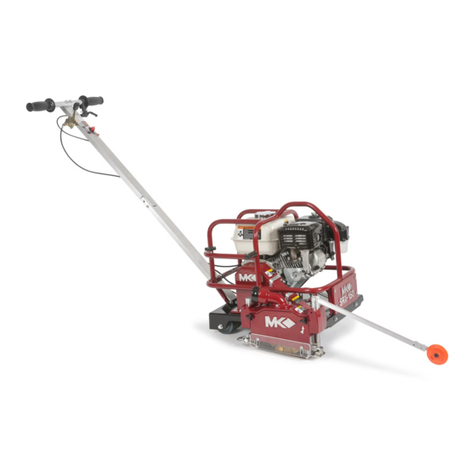ATECH CRATER-06 A/550 User manual

CRATER –06 A/550
HEAVY DUTY 22” (550 mm) AUTOMATIC UPCUT MITER SAW
USER’S MANUAL

1
CONTENTS
1. GENERAL INFORMATION
1.1. Introduction
1.2. Information About The Distributor
2. MACHINE’S DESCRIPTION AND PURPOSE OF USE
2.1. Machine’s Description
2.2. Technical Features
2.3. Cutting Diagram
2.4. Dimensions
2.5. Electric And Pneumatic Control Panel
2.6. Parts List and Technical Drawings
3. SAFETY
3.1. Safety Information
3.2. Accident Prevention
3.3. General Safety Information
3.4. Safety Symbols And Meanings
4. TRANSPORT OF THE MACHINE
5. INSTALLATION OF THE MACHINE
5.1. Preparation
5.2. Instructions About Safe Connection Of The Machine To The Power Source
5.3. Air Pressure Setting
6. MACHINE SAFETY DATA
7. OPERATION
7.1. Miter Cuts
8. SAFE REPLACEMENT OF THE SAW BLADE
9. SAFE RAPLACEMENT OF THE BELT
10. MAINTENANCE
10.1. Routine Controls, Maintenance And Work Starting
10.2. Hydro-Pneumatic Cylinder Air Discharge and Adding Oil
10.2.1. Hydro-Pneumkatic Cylinder Air Supply
10.2.2. Adding Oil
10.3. End of Working Day Maintenance
11. TROUBLESHOOTING GUIDE
12. COMPONENTS
12.1. Electric Components
12.2. Hydraulic-Pneumatic Components

2
1. GENERAL INFORMATION
1.1. Introduction
The user’s manual given by the manufacturer contains information about the machine parts. Each machine operator
should read these ınstructions carefully, and the machine should be operated after fully understanding them.
Safe and efficient use of the machine for long term depends on understanding and following the instructions contained
in this manual. The technical dtawings and details contained in this manual constitute a guide for the operator.
1.2. Information About The Manufacturer
ATech Machine, Inc.
Ph.: 1-855-ATECH-US
Fax: 301-560-6627
info@ATechMachinery.com
*In case of any technical problem please contact your nearest ATECH dealer or ATECH head office through the above
mentioned phone, fax or e-mail address.
*Technical labels with the model description of the machine are fixed onto the front side of each machine.
*The machine’s serial number and manufacturing year are stipulated on the technical label.
2. MACHINE’S DESCRIPTION AND TECHNICAL FEATURES
2.1. Machine’s Description
Designed for straight and miter cut at any angle of PVC, Aluminum and wooden profiles. The operator adjusts the cutting
progress (manually from the cutting speed setting) of the saw according to the type and size of the material.
➢The machine has been designed inf full conformity with CE, UL and CSA Safety Directives.
➢15ᵒ- 22,5ᵒ- 30ᵒ- 45ᵒ- 90ᵒthe angles are set via locking pin, any intermediate angle by tightening the handle.
➢It is possible to adjust the rising speed of the saw blade according to the material to cut.
➢During the cutting process, if the top guard cover is opened, the saw blade stops and moves down automatically due
to safety reasons.
➢After cutting is completed or the cutting start buttons released, the saw blade moves down to the start point
automatically.
STANDARD ACCESSORIES
•Ø550 mm (22”) Saw Blade
•Air Gun
•Twin Vertical & Horizontal Pneumatic Clamps
•Pneumatic Spray Mist Lubrication System
•Chip Collector Manifold
•User’s Manual
OPTIONAL ACCESSORIES
•Infeed & Outfeed Tables
•Extra Saw Blade
Please mention the below mentioned data in all your correspondence regarding the machine with the manufacturer
and/or your ATECH dealer.
•Machine model
•Machine’s serial number
•Voltage and frequency
•Name of dealer where machine was purchased
•Date of purchase
•Description of the machine fault
•Average daily operation period
2.2. Technical Features

3
2.3. Cutting Diagram
2.4. Dimensions
2.5. Electric And Pneumatic Control Panel
The electric and pneumatic control panel allows you to make adjustments to the air pressure. The panel cover must be
definitely closed and locked during operation. Service and maintenance work to remedy any malfunctions;
DISCONNECT POWER AND PNEUMATIC POWER SUPPLIES.
Air pressure safety switch mounted on panel disables all pneumatic components as operational safety if air pressure drops
below 6 Bar (90 psi).
Saw blade will not rise and pneumatic clamps not activated air pressure drops below 6 Bar (psi)

4
2.6. Parts List and Technical Drawings
#
Image
Definition
Qty
Part Code
1
Ø550 Saw Blade
1
CRA550-02-0001
2
4 kW (5.5 HP) Motor
1
CRA550-04-0002
3
Motor Connection Block
1
CRA550-02-0003
4
Belt Pulley
Protection Part
1
CRA550-02-0004
5
Motor Tension
Sheet Metal
1
CRA550-02-0005
6
Motor Tension Bolt
Print Washer
1
CRA550-02-0006
7
Motor Tension Block
1
CRA550-02-0007
8
Belt
1
CRA550-02-0008
9
Saw Blade Shaft
1
CRA550-02-0009

5
10
Motor Pulley
1
CRA550-02-0010
11
Motor Pulley Washer
1
CRA550-02-0011
12
Coupling
1
CRA550-02-0012
13
Washer (30-32mm)
1
CRA550-02-0013
14
Saw Blade Flange
1
CRA550-02-0014
15
Saw Blade Washer
1
CRA550-02-0015
16
Saw Blade Shaft Nut
1
CRA550-02-0016
17
Saw Blade Shaft Tube
1
CRA550-02-0017
18
6206 ZZ Bearing
2
CRA550-02-00018
19
Bearing Cover
2
CRA550-02-0019
20
Piston-Hydro-
pneumatic cylinder
Connection Part
1
CRA550-02-0020
21
Hydro-Pneumatic
Cylinder
1
CRA550-03-0021

6
22
Pneumatic Cylinder
1
CRA550-03-0022
23
Saw Blade Guard
1
CRA550-01-0023
24
Table Fence
2
CRA550-02-0024
25
Vertical Pneumatic
ClampCylinder
2
CRA550-03-0025
26
Horizontal Pneumatic
ClampCylinder
2
CRA550-03-0026
27
Standard Angles Locking
Pin
1
CRA550-02-0027
28
Manual Conveyor
1
CRA550-01-0028
29
Chip Collector Manifold
1
CRA550-01-0029
3. SAFETY
3.1. Safety Information
The symbols shown hereunder are necessary to be read with special attention. Not reading or observing of them may cause
damage to the equipment or personal injury.
The IMPORTANT symbol above is one telling to apply special care and to be careful at carrying out the specified
operation.
The CAUTION! symbol above warns you against specific dangers and requires to read the text. Not observing may cause
damage to the equipment.

7
The above symbol DANGER WARNING, warns you against specific dangers and you have definitely to read them. Negligence
may cause damage to the equipment and bodily injury. Read the user’s manual carefully before using the machine or carrying
out maintenance works.
3.2. Accident Precention
3.2.1. Our machines are manufactured in accordance with EN 60204–1 and EN 292–2 CE safety directives,
which cover national and international safety directives.
3.2.2. It is the task of the employer to warn his staff against risks, to train them on prevention of accident, to
provide for necessary safety equipment and devices for he operator’s safety.
3.2.3. Before starting to work with the machine, the operator should check the features of the machine, learn all details
of the machine’s operation.
3.2.4. Machine should be operated only by staff members, who have read and understood the contents of this manual.
3.2.5. All directives, recommendations and general safety rules contained in this manual have to be observed fully. The
machine cannot be operated in any way for purposes other than those described herein. Otherwise, the
manufacturer shall not be deemed responsible for any damages or injuries. And such circumstances would lead to
the termination of the warranty.
3.3. General Safety Information
3.3.1. The power cable should be led in such a way that nobody can step on it or nothing
can be placed on it. Special care be taken regarding the inlet and outlet sockets.
3.3.2. If the power cable should be damage during operation, don’t touch and unplug it.
Never use damaged power cables.
3.3.3. Don’t overload machines for drilling and cutting. Your machine will operate more
safely with power supply in accordan CE with the stipulated values.
3.3.4. Don’t place your hands between parts in motion.
3.3.5. Use prtective eye glasses and ear plugs. Don’t wear oversize clothes and jewels.
These can be caught by moving.
3.3.6. Keep your working place always clean, dry and tidy for accident prevention and safe
operation.
3.3.7. Use correct illumination for the safety of the operator. (ISO 8995-89 Standard The
Lighting of Indoor Work System)
3.3.8. Don’t leave anything on the machine.
3.3.9. Don’t use any materials other than those recommended by the monufacturer for
cutting operations on the machine.
3.3.10. Ensure that the work piece is clamped appropriately by the machine’s clamp or vice.
3.3.11. Ensure safe working position, always keep your balance.
3.3.12. Keep your machine always clean for safe operation. Follow the instructions at
maintenance and replacement of accessories. Check the plug and cable regularly. If
damaged, let it replace by a qualified electrician. Keep handles and grips free of any
oil and grease.
3.3.13. Unplug first, before conducting and maintenance works.
3.3.14. Ensure that any keys or adjustment tools have been removed before operating the
machine.
3.3.15. If you are required to operate the machine outside, use only appropriate extension
cables.
3.3.16. Repairs should be carried out by qualified technicians only. Otherwise, accidents amt
occur.
3.3.17. Before starting a new operation, check the appropriate function of protective devices
and tools, ensure that they work properly. All conditions have to be fulfilled in order
to ensure proper operation of your machine. Damaged protective parts and
equipment have to be replaced or repaired properly (by the monufacturer or dealer).
3.3.18. Don’t use machines with improper functioning buttuons and switches.
3.3.19. Don’t keep flammable, combustive liquids and materials next to the machine and
electric connections.
3.4. Safety Symbols And Meanings
Electric warnings.
Use protective goggles.

8
If main connection cable is
damaged during operation, do not
touch it and disconnect the main
plug from main socket.
Use protective earmuffs.
When machine is working, do not
make your hand close to saw blade.
Use protective gloves when
changing the saw.
Keep working environment clean,
dry and tidy.
Read operating instructions
carefully before using or
maintaining the machine.
4. TRANSPORT OF THE MACHINE
*The transport should be done by qualified personnel only.
4.1.1. The machine should be transported by lifting with proper equipment (not touching the ground during the
transport).
4.1.2. Don’t lift the machine before ensuring that lifting devices or other equipment is placed properly under the machine.
4.1.3. For the weight and dimensions of the machine, 2.2. Technicial Features
5. INSTALLATION OF YOUR MACHINE
The machine should be located at least 50 cm (20”) in front of the back wall. The machine is equipped with a chip collection
bag connector and power supply socket on the back side.
5.1. Preparation
5.1.1. The outer dimensions of the machine are stipulated in the dimensions page. The ground, where the machine will be
placed, should be even, solid enough to bear the weight of the machine.
5.1.2. At the double head automatic saw machine Crater all parts are delivered by the manufacturer ready for use.
5.1.3. Do not make electrical connections without removing the bolt and stop connections used for the detection of running
systems before the machine is started and without wiping the protective oil layer in working parts.
5.2. Instructions For Safe Connection Of The Machine To The Power Source
5.2.1. The three-phase electrical cable socket must have five inputs to the cable on the machine.
5.2.2. Use a connection cable sockets in accordance with the CE, UL and/or CSA Safety Directives.
5.2.3. Check the inlet power supply before powering the machine.
The socket connections have to be made by a qualified electrician, the rotation direction of the saw blade has to be observed
by starting the machine. If the saw blade rotates in reverse direction, the socket connections have to be checked and re-
connected properly. If the direction of rotation of the saw blade is reversed, it is dangerous to Operator and equipment. It causes
the saw teeth to break and cracks.

9
Plug the machine's electrical power socket into the previously prepared 3-phase socket socket to follow the saw-turn
direction and follow the following procedures:
1. Press the motor start button to rotate the saw.
2. Observe the direction of rotation of the saw.
3. The direction of rotation of the saw is available on the turn direction label on the table.
If the saw blade rotates in reverse direction: The electric socket connections have to be checked and corrected by a qualified
electrician. The direction of rotation of the saw must not be run without testing.
5.3. Air Pressure Setting
For the pneumatic system to operate properly, the air pressure must be 6-8 bars. Do not operate at lower pressures than
6 bars. Read the manometer on the conditioner to calibrate and check the air pressure.
Follow the steps below for air pressure settings.
5.3.1. Pull up the conditioner adjustment knob.
5.3.2. The pressure increases when the knob is turned clockwise, while the pressure decreases when it is turned counter-
clockwise.
5.3.3. When you read the 6-8 Bar pressure setting on the pressure gauge, lock the conditioner setting knob.
5.3.4. The conditioner unit accumulates the water contained in the air system into the collection container so as not to
damage the pneumatic system components. Automatically removes water collected when air is supplied to the
machine.
5.3.5. The oil recommended by the manufacturer in the conditioner is TELLUS C 10 / BP ENERGOL HLP 10 / MOBIL DTE
LIGHT / PETROL OFFICE SPINDURA 10.
6. MACHINE SAFETY DATA
6.1.1. It is not allowed to operate the machine with the protective cover and other protective equipment removed.
6.1.2. Your machine operates with 400V ~ 3 Phase 50Hz. Let the electric installation of your machine carry out by a qualified
electrician only. Grounding must be done. There will be irregularities in machine operation if grounding is not done
properly.
6.1.3. Lifting, installation, electric, pneumatic maintenance of the machine should be carried out by qualified personnel
only.
6.1.4. Routine maintenance and scheduled maintenance should be carried out by qualified personnel after unplugging the
machine and disconnecting the air supply first.
6.1.5. Ensure that the machine has been cleaned, tested and maintenance before starting to operate.
6.1.6. Check the safety devices, power cable and moving parts regularly. Don’t operate the machine before having replaced
defective safety devices or faulty parts
6.1.7. Never replace the circular saw without disconnecting the air and the electrical and pneumatic power connection.
6.1.8. Keep foreign materials away from the working area of the machine, keep away from the machine’s moving parts.
The saw blade continues its rotation for a while after switching off the motor.
Don’t use the machine for purposes other than it has been designed for (cutting of iron and other ferrous
materials).
The safety data have been defined above. In order to prevent physical damage or damage to the
equipment, please read the safety information carefully and keep the manual always in an easy accessible
place.
If the top guard is open, the motor will not start for safety reasons.
Top Guard
Control Panel
Electric and Pneumatic Panel

10
7. OPERATION
CRATER upcut saws are for cutting of non-ferrous metals like aluminum, vinyl (PVC) and wood. The operator adjusts the
rising speed of the saw blade type and size of the material. The inner and outer sharp edges of the circular saw blade allow
you to obtain a smooth surface at high quality.
7.1. Miter Cut
7.1.1. Do not try to cut the parts / materials that you want to cut before activating the pneumatic clamps on the machine
via the clamp switch on the operator panel.
7.1.2. The clampss on the machine are in vertical or horizontal position. The pneumatic clamps can be easily adjusted
according to the material, up & down and right & left.
7.1.3. The clamp piston moves in the pneumatic clamps.
During the cutting process, the clamp tips of the clamps must remain outside of the work area of the circular
saw blade.
CORRECT
WRONG
7.1.4. Avoid touching the buttons on the operator panel randomly. In emergency situations during cutting, press the
emergency stop button immediately to terminate the cutting process.
7.1.5. Close the front door on the chassis and control panel and lock it with the key. (If the chassis front cover is open, the
motor will not operate for safety reasons).
NOTE: The chassis front cover and rear panel cover can only be opened when the machine is serviced and cleaned, or when
the saw blade is replaced. At this time, turn the Main Switch's position to position 0 and turn off the power, then open the
front and back panel covers.
7.1.6. Set the cutting angle of the material to be cut according to the graduated scale (150- 22,50-300-450-900etc) on the
machine. Loosen the tab lock retaining screw by turning it clockwise to rotate the turntable. Set the angle to which
you want to work with the angle adjustment switch. Do the reverse operation of loosening the turntable to secure it.
Do not use the horizontal clamp on the side where the saw blade rotates when cutting bigger than 45 ° angle.
NOTE: When performing miter cut operations on the machine, make sure that the clamps and right-
left miter frames are out of the operation area.
7.1.7. Set the length of the material to be cut to the desired unit of measure in meters. Once the desired piece size has been
set, tighten the piece to fix the profile rest.
7.1.8. Ensure that the vertical pneumatic vices tighten the piece using the vise button on the machine.
7.1.9. Press the motor start button to rotate the saw.
7.1.10. Start the cutting operation of the saw balde by pressing both cutting start buttons simultaneously.
7.1.11. The circular saw blade will cut the fixed profile with the upward movement and continue to the closed position until
the cut start button is pressed again after the cutting operation is finished.

11
7.1.12. Cut the saw by manually adjusting the cutting speed adjustment valve according to the type and size of the material
to be sawed and cut the cutting process until the saw cuts down again.
7.1.13. Using the clamp button, remove the print on the clamps and remove the cut off piece.
Set the air pressure between 6-8 bars. The manometer is read as air pressure bar. If the reading on
the pressure gauge is less than or equal to the desired pressure, turn the air pressure adjustment
switch to the right or left to adjust the pressure to 6-8 bar. If your air pressure drops below 4 Bar,
the saw movement on the machine and the vices will not work until the air pressure is returned to
the desired level due to operational safety.
7.1.14. The conditioner unit collects the water contained in the air system into the collection container so as not to damage
the pneumatic system components. Periodically (on the working day) drain the water by pressing or opening the
button under the conditioning cylinder deposit to drain the collected water.
8. SAFE INSTALLATION OF THE SAW BLADE
To remove the circular saw blade from the saw blade shaft, apply the following sequence.
8.1.1. Cut off the machine's electrical and air connection. Open the control panel with the front cover lock on the chassis,
remove the side cover sheet metal. (Figure 1, 2)
8.1.2. Remove the saw blade guard. (Figure 3)
8.1.3. Remove the M10 screw by turning with a 8 mm allen key (Hold the saw blade shaft at the opposite end with a other
8 mm allen key and prevent so that the shaft turns). (Figure 4, 5)
8.1.4. Remove the 30x8x7mm washer and Saw Flange parts regularly. (Figure 6)
8.1.5. Carefully remove the saw blade.
8.1.6. Replace it with the new saw blade on the shaft, making sure the direction of rotation is correct.
8.1.7. When replacing the saw blade with the new one, use the portion of the saw blade that corresponds to the saw
blade diameter. The outer diameter of the saw ring is two parts according to 30 and 32mm.
8.1.8. Fit the other parts (Washer and Saw Flange) in order, following the reversal of the operations on the shaft.
8.1.9. Tighten the M10 screw by turning it clockwise with an 8 mm Allen key (Hold the saw blade shaft at the opposite end
with a other 8 mm allen key and prevent so that the shaft turns).
8.1.10. Install the saw cover. Close the chassis side cover plate and control board.
NOTE: The saw blade you use must be sharpened / changed at certain intervals depending on the type of material being
cut. When the cut workpiece is burrned at the end of cutting or when the cutting is forced, sharpening / changing
operation is performed.
Pressure
Adjustment Knob
Manometer
Air Pressure and
Water Discharge
Oil Storage
Oil Additional
Stopper
Fixed Miter

12
Figure 1 : Open The Control Panel And The Side Cover Plate.
Figure 2
Figure 3
Figure 4
Figure 5
Figure 6
Saw Blade Flange
Washer
30x8x7
Saw Blade
Washer
M10x20 Inbus
Screw
Ø550 (22”) mm Saw Blade
Coupling

13
9. SAFETY INSTALLATION OF THE BELT
Follow the instructions below to safely replace the motor belt.
9.1.1.Remove the saw blade by following the respective instructions for the saw blade.
9.1.2.Remove the saw blade guard assembly.
9.1.3.Remove the M6 screw by turning with a 5 mm allen key.
9.1.4.Remove the belt cover.
9.1.5.Loosen the M10 key-head bolt with the 10 mm keys.
9.1.6.Loosen the M8 screws by turning them clockwise with a 6 mm Allen key.
9.1.7.You can change the belt by loosening the motor block.
9.1.8.Once you have changed the belt, finish the process by following the procedures.
10. MAINTENANCE
10.1. Routine Controls, Maintenance And Work Starting
10.1.1. Make sure the table and all parts are clean and dry. Clean the table from the oil and dry it. Be especially sure of the
cleanliness and dryness of the handle.
10.1.2. Clean all surfaces of the machine from the sawdust, chips and foreign materials. Use glasses and glove to protect
yourself from harmful substances.
10.1.3. Check the saw blade against wear, bending, cracking and breakage before each use. Turn carefully to see each tooth
of the saw (after removing the saw protective housing). If the saw is damaged, change the saw.
10.1.4. Check the air pressure system pressure. If necessary, set the air pressure around 6-8 bar.
10.1.5. Check the air pressure filters and the oil level in the conditioner. If you do not have enough oil, complete it.
Loosen with 10 mm key

14
Disconnect the electrical power connection and air pressure connections before doing all this.
10.2. Method Of Hydro-Pneuamtic Cylinder Air Discharge And Adding Oil
10.2.1. Method Of Hydro-Pneumatic Cylinder Air Discharge
1. Remove 4 imbus head bolts that connect the hydro-pneumatic cylinder.
2. Remove the countersunk head bolt from the top of the torso, which is connected to the hub of the machine.
3. Remove the nut connecting the speed setting (min-max) unit to the left of the front control panel.
4. Remove the hydro-pneumatic cylinder.
5. Pull out the shaft in the hydro-pneumatic cylinder to be in the ON (out) position.
6. In the position shown in the picture, the unit to the clamp so that the system is not damaged connect/tighten.
7. Open the oil drain / deaeration unit plug as shown in the picture..
8. Press gently on the top of the oil discharge unit with a flat, blunt metal (for example 3 allen).
a. Foamy oil will come in the first place during the press.
b. Continue this process slowly until the unfoamed oil comes
9. When the oil is foam free stop the process and wipe with a dry cloth. Replace hydro-pneumatic cylinder
10.2.2. Adding Oil
There is a possibility of a handicap after the air reception process. That's the rising height of the saw blade. Since the
amount of oil in the system is reduced, the rising distance of the saw blade can be reduced. Here's what you need to do to
get your saw blade to reach the maximum height again. An oil pump is necessray operation for adding oil. However, if you do
not have the necessary oil pump you can do the following as well.
1. Follow the same steps until the first 6 items of hydro-pneumatic cylinder air discharge.
2. Remove the oil filler unit.
3. Add "HYDRO OIL HD 46" or equivalent oil to the system and close the oil filling unit.
4. Repeat steps 7 and 8 of the hydrocheck air reception method to get any air that may form in the system.

15
10.3. Work Day End Care
10.3.1. Disconnect the electrical and pneumatic power connections.
10.3.2. Clean all surfaces of the machine from the sawdust, chips and foreign materials. If cleaning of the protective housing
is necessary, remove the front cover and wear gloves to protect your hands from the cutting edges of the saw. Use
glasses to protect yourself from harmful substances.
10.3.3. If water and water based liquids are used during cutting operations, dry the machine with dry cloth at the end of the
work.
10.3.4. Apply a thin layer of oil to the plate to protect it from corrosion. If it is not to be used for a long time, lubricate with a
protective oil.
10.3.5. Avoid materials that damage the paintwork while cleaning the machine.
10.3.6. Lubricate both surfaces with machine oil or a protective oil to protect the saw from corrosion.
11. TROUBLESHOOTING GUIDE
Here are our suggestions to get rid of immediate problems. If the fault can not be rectified or if you encounter a fault other
than those listed below, please contact the technical service.
TROUBLES
CAUSES
REMEDY
Low surface quality (at aluminum
and similar materials);
•Rough surface,
•Large chip,
•Not homogenous surface,
•Saw blade traces visible
Not cooling the saw blade surfaces.
Lubricating the saw blade cutting
surfaces,
Using of cooling liquid.
Using of damaged or blunt saw
blade or the saw rotating in reverse.
Check the saw blade teeth. Replace if
necessary. Check the electricity.
Saw blade moves to quick.
The cutting speed is too high fort he
material. Decrease the cutting speed.
Motor does not work (Start button
is pressed, not working)
No power supply to the machine.
Check the electric cable connections.
Check the electric power sockets.
Motor is working but the pneumatic
clamp piston do not work.
The air supply connections are
missing, or the air pressure is too
low.
Check the air compressor connections.
Adjust the air pressure between 6-8 Bar
on the conditioner.
The saw blade rotates in reverse
direction.
The electric connection or the
power cable is wrong.
Let the electric connections carry out by
a qualified electrician.
12. COMPONENTS
12.1. ELECTRIC COMPONENTS
12.2. HYDRAULIC-PNEUMATIC COMPONENTS
PART NAME
QTY
ELECTRIC MOTOR
1
POWER CABLE 4x1,5 mm
3,5 m
PART NAME
QTY
FRC 1/8 D MINI CONDITIONER
1
PNEUMATIC CLAMPS
2
DMC-A Ø63 x 246 PNEUMATIC CYLINDER
1
SPC Ø50 x 25 PNEUMATIC CYLINDER
2
HYDRO-PNEUMATIC CYLINDER
1
Table of contents
Other ATECH Saw manuals
Popular Saw manuals by other brands

Dremel
Dremel SM20 Operating/safety instructions
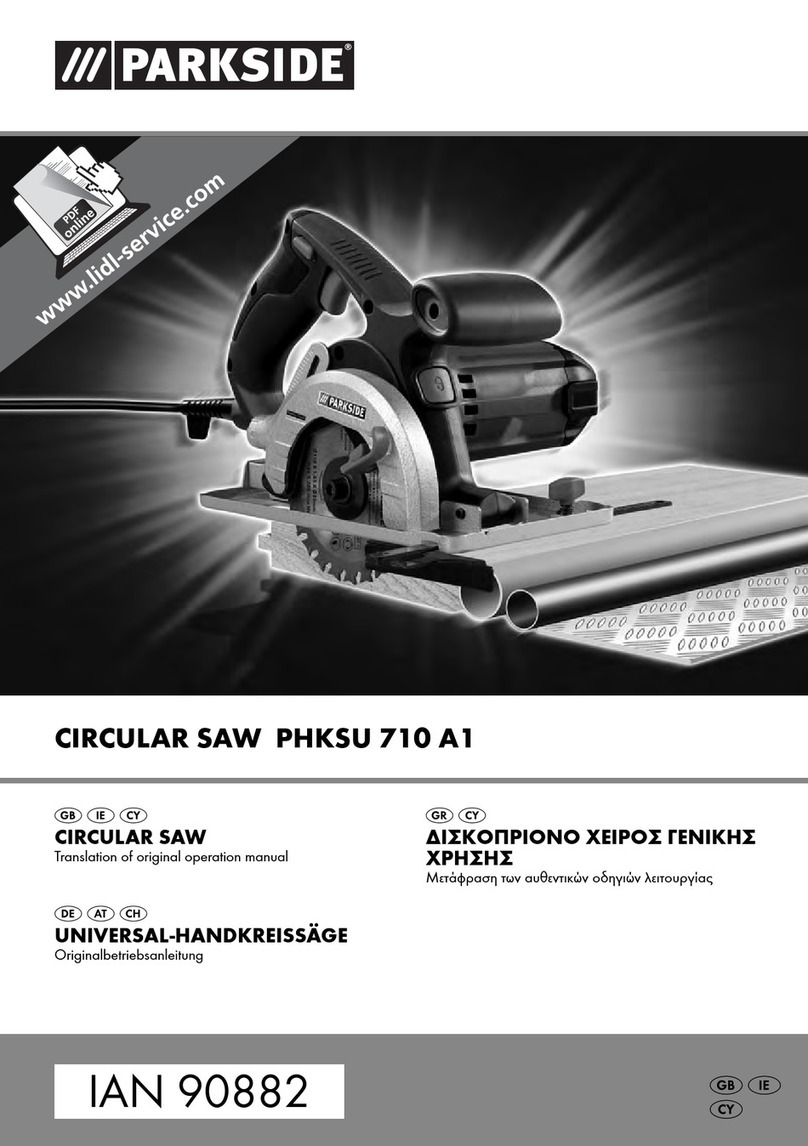
Parkside
Parkside 90882 translation of original operation manual
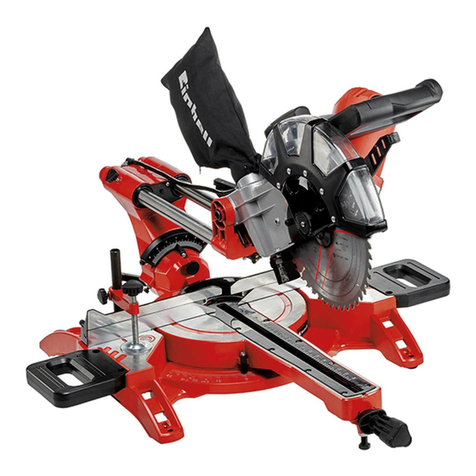
EINHELL
EINHELL TC-SM 2534 Dual Original operating instructions
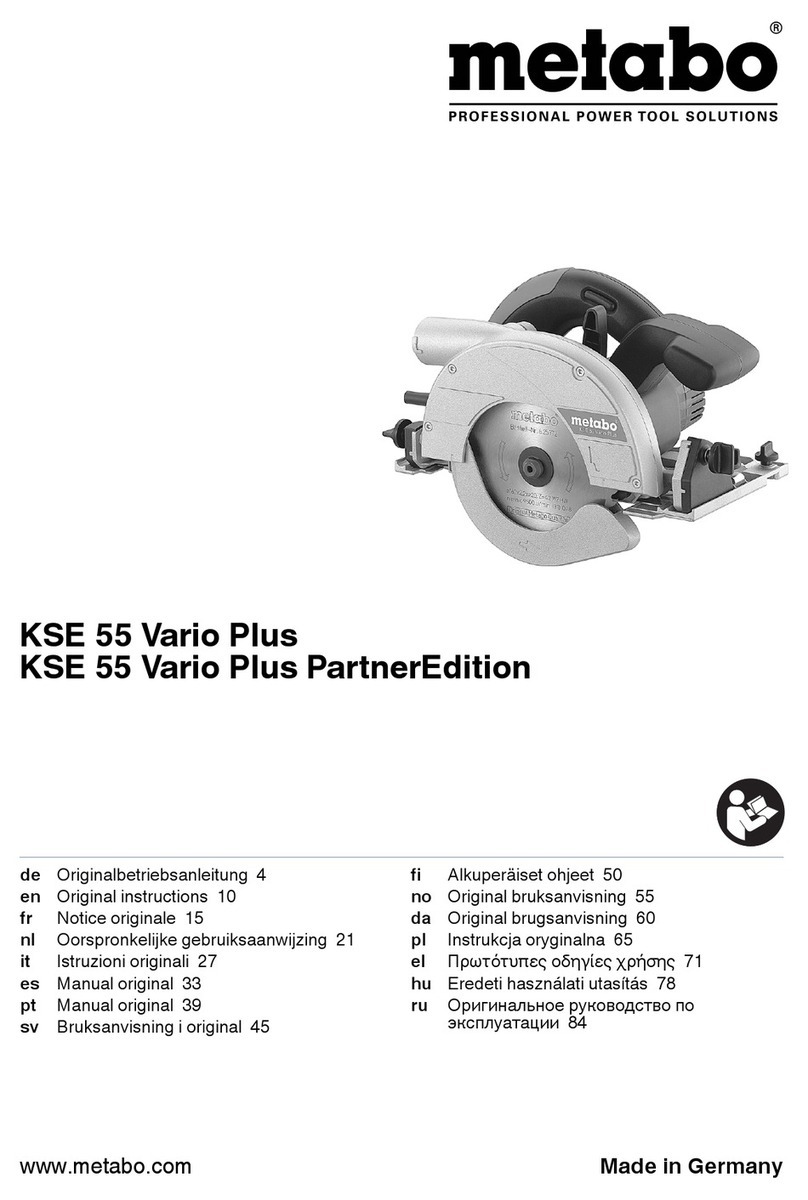
Metabo
Metabo KSE 55 Vario Plus PartnerEdition Original instructions

King Industrial
King Industrial KC-2102FXR instruction manual

Specialty Saw
Specialty Saw Clean-Cuts HYDM140 instruction manual
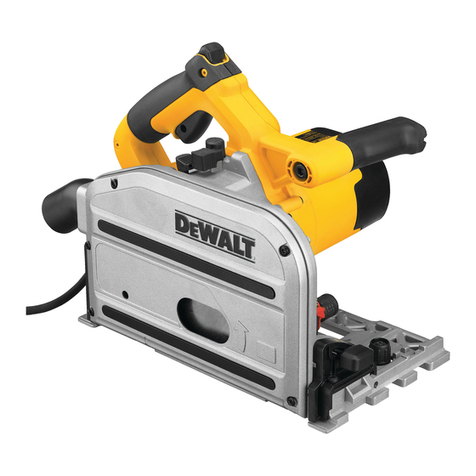
DeWalt
DeWalt DWS520 Original instructions
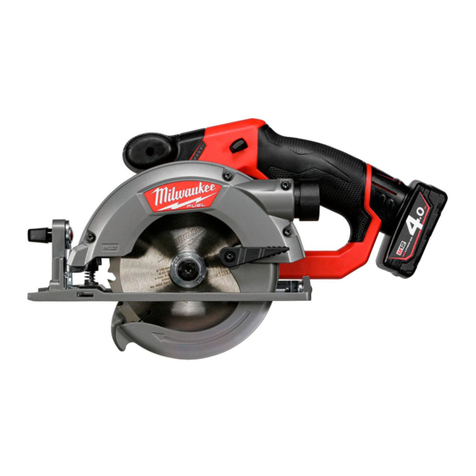
Milwaukee
Milwaukee M12 CCS44 Original instructions
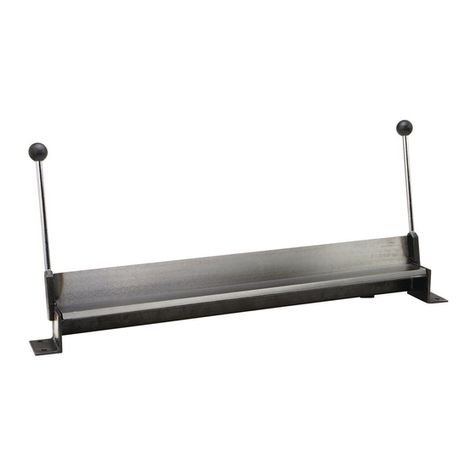
Central Machinery
Central Machinery 41311 Assembly and operating instructions
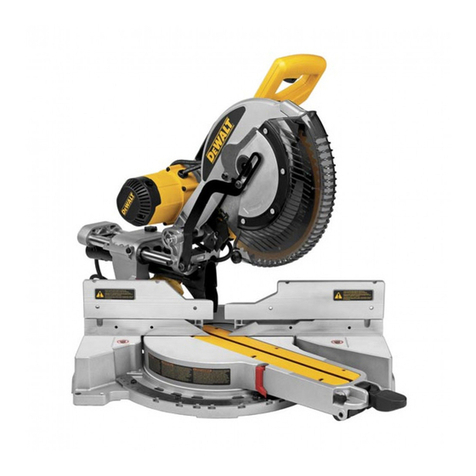
DeWalt
DeWalt DWS780 instruction manual
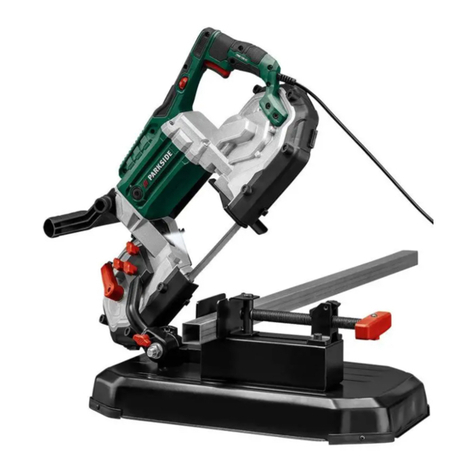
Parkside
Parkside 322848 1901 Translation of the original instructions
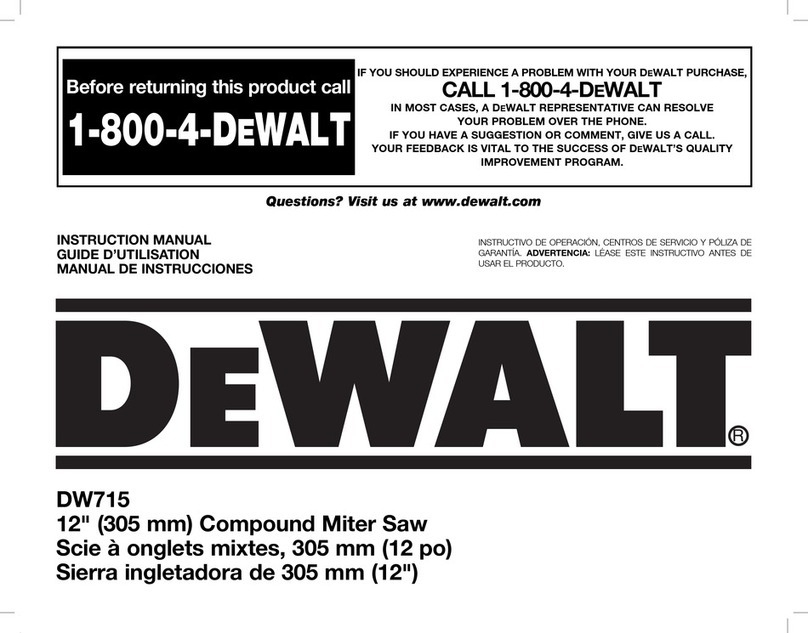
DeWalt
DeWalt DW715 instruction manual
